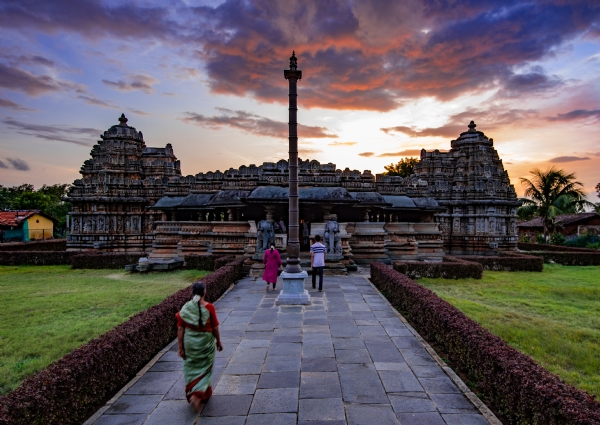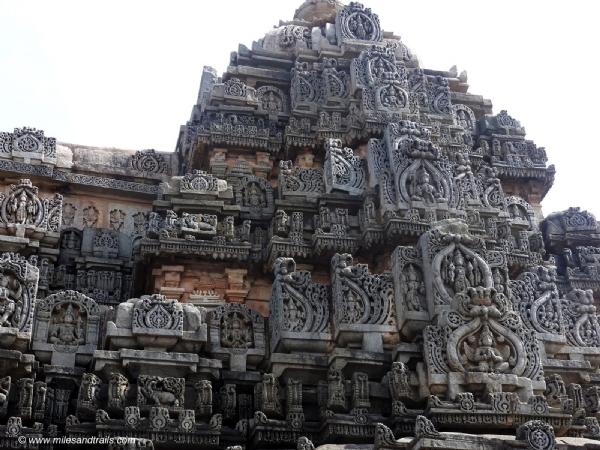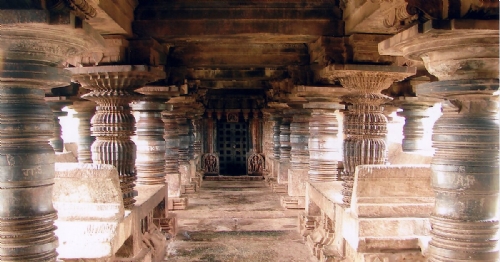Veera Narayana Temple, the trikuta shrine in Belavadi, Karnataka
This ornate temple was actually built in the 1200 C.E. by Hoysala Empire King Veera Ballala II using soapstone material
Total Views |
Some of the most famous temples in South India are in Halebid or Belur regions. But really close to these towns is where you will find a trikuta temple, which one of the most grand and special ones you will come by. The Veera Narayana temple is situated in Belavadi village in Chikmagalur district, Karnataka. It has been built beautifully in the Hoysala style, and is also known as the Ekachakranagara temple. It is located very near to the famous temple villages of Belur & Halebid. This temple was built in the 13th century by Veera Ballala II. While Belur and Halebid are famous for their intricate sculpture, this temple is the best-known examples of classic Hoysala architecture.



Malik Kafur entered Karnataka in 1311 CE and laid siege to Halebid, ruled by Hoysalas. Hoysalas agreed to pay tribute to him. Even then, Kafur managed to destroy the Hoysaleswara temple and many others in the area. The head priest of Belavadi claims that Kafur had come up to nearby Tarikere. But due to its location, Belavadi, in a quaint mountainous village, narrowly escaped the Islamic destruction.

History | This ornate temple was actually built in the 1200 C.E. by Hoysala Empire King Veera Ballala II. The material used to build the temple is soapstone. Each of the three shrines has a complete superstructure (tower on top of shrine) and is one of the largest temples built by the Hoysala kings.
Architecture | Built in the trikuta (3 shrined) style, having 3 vimanas, this temple is truly huge and spacious. The entrance of the temple is at the centre and has slanting roofs. The few steps leading up to inside of the temple are bordered by an elephant on either side of it. The older shrine is in the centre, while the two other shrines face each other across the mandapa.
The older shrine has one closed Mandapa and an open one. One of them has 13 bays, and the one with 9 bays. The vimana of this shrine is beautifully decorated. The outer walls of this temple have beautifully carved pilasters with decorative towers on the top.
The two newer shrines face each other, and are uniquely connected by an open Mandapa with 37 bays. These two shrines have different plans. One is square while the other is star shaped. The vimanas, the Sukanasi and the walls are all covered with bold sculptures. The figures that stand out are the ones of Krishna dancing on Kaliya, and one of Garuda. The central shrine has an idol of Veera Narayana, with four arms, standing on a lotus. This figure is 8 ft tall. This is the central shrine here, and also the oldest one.
Also Read | Bhoga Nandeeshwara Temple, the 9th century shrine of Lord Shiva
The northern shrine has a 7 ft idol of Yoganarasimha in a sitting posture, holding the Shanka and Chakra, with Sridevi and Bhoodevi standing on either side. The Prabhavati is carved with the ten avatars of Vishnu.

The southern shrine has an enchanting 8-foot image of Venugopala Krishna. He is surrounded by various figures – Shravan Kumaras with folded hands, Gopikas, who are so lost in the music that one has forgotten to cover herself properly, a cow feeding her calf, lost in the music, Gopalas who are dancing to the Venu Gana. On either side of Venu Gopala stand Rukmini and Satyabhama.
Also Read | Dayara Bugyal, the alpine wonder of Uttarakhand
The temple escaped Islamic destruction | The age when Hoysalas were building great temples was also the age of Islamic iconoclasm in India. The radical zeal of invading Islamic kings of the Delhi Sultanate had broken upon Southern India.
Malik Kafur entered Karnataka in 1311 CE and laid siege to Halebid, ruled by Hoysalas. Hoysalas agreed to pay tribute to him. Even then, Kafur managed to destroy the Hoysaleswara temple and many others in the area. The head priest of Belavadi claims that Kafur had come up to nearby Tarikere. But due to its location, Belavadi, in a quaint mountainous village, narrowly escaped the Islamic destruction.


